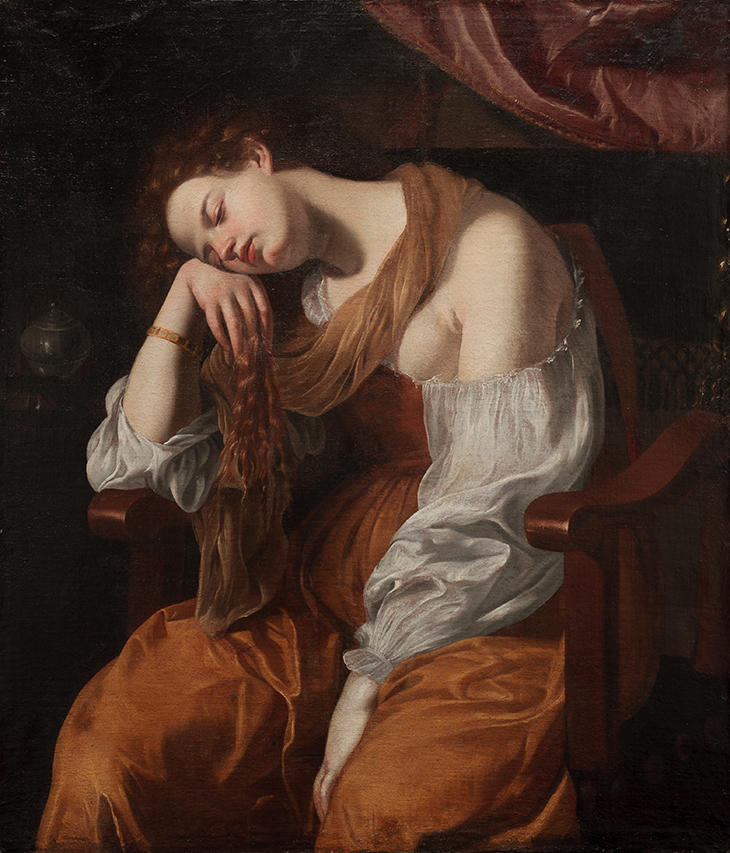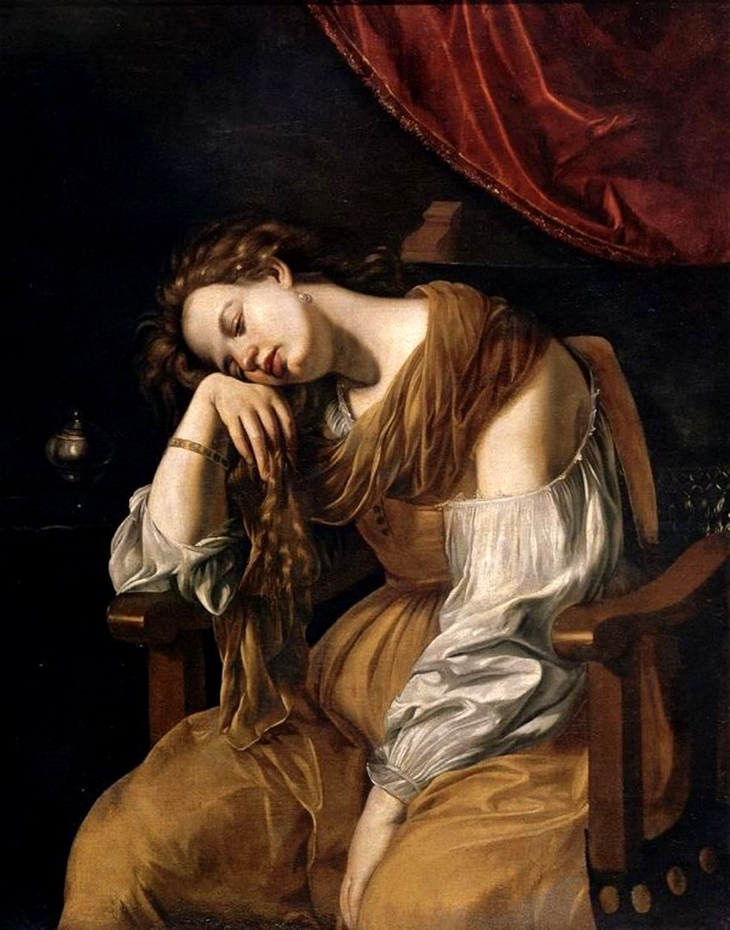With archives, libraries and museums often shuttered and travel restricted, these past 18 months have been difficult ones for carrying out art-historical research. Trying to make the best of it, I found myself scouring footnotes or rereading old research notes from the confines of home. Over the course of this summer, I came across a reference to an unpublished ‘copy’ of a long-lost Mary Magdalene by Artemisia Gentileschi that I had never followed up on – and which can now be confidently identified as the artist’s original work.
Penitent Mary Magdalene (1625–26), Artemisia Gentileschi. Private collection

It has long been known that, in around 1625, Artemisia painted a Penitent Mary Magdalene for the Spanish ambassador to Rome, Fernando Enríquez Afán de Ribera, the third Duke of Alcalá. When the duke returned to Seville in 1626, he brought it back with him – along with paintings by Jusepe de Ribera, Guido Reni, the Cavalier d’Arpino and other artists he had encountered in Italy. Artemisia’s Penitent Magdalene is known through copies in Seville Cathedral and in the Museo Soumaya in Mexico City, as well as two other unpublished replicas. These paintings portray a half-length Magdalene, seated in a chair, her eyes swollen from crying, her head tilted and resting on her bent right hand in a gesture that recalls the traditional iconography of melancholy, and her sleeve slipping off her left shoulder. On the table beside her are a metal ointment jar and a mirror, and behind her is a red curtain. Even before the painting left Rome, it seems to have inspired Simon Vouet’s remarkable portrait of his wife in Virginia da Vezzo as Mary Magdalene (Los Angeles County Museum of Art). Seventeenth-century Spanish sources indicate that, after it arrived in Seville, the painting became famous and was widely copied. Yet despite its fame, the original painting subsequently disappeared.
Virginia da Vezzo, the Artist’s Wife, as the Magdalen (1626–27), Simon Vouet. Los Angeles County Museum of Art

Through some investigation, I learned that the unpublished painting to which I had found a reference was in a private American collection. A few months ago I had the chance to examine this painting in person, accompanied by Sheila Barker, one of the leading authorities on Artemisia Gentileschi. We went to see it cautiously optimistic that it might be the real thing (but also well aware of the many copies out there). But the painting far exceeded our expectations. In every respect, it is clearer, brighter, more legible, and better painted than the other versions, and shows a subtlety of light and colour, and masterful portrayal of flesh and fabric, that is consistent with the artist at the height of her powers. Moreover, details that are ambiguous, awkward or illogical in the copies are resolved and clarified in this version.
The painting was purchased by the current owner in 2001 from Tajan auction house in Paris and attributed to the ‘atelier of Artemisia Gentileschi’. At the time of purchase it was dirty and marred by clumsy, but thankfully superficial, repainting: most notably, the Magdalene’s blouse had prudishly been extended to cover the provocative bit of exposed flesh at the armpit and the top of the breast. In addition, that later artist had ineptly repainted an earring that had likely rubbed off. Despite the overpainting, a heavy-handed relining in an earlier period and a few minor repairs by a previous owner, the work is in excellent condition. A straightforward cleaning of the painting shortly after its purchase revealed a nuanced and masterful work underneath, and numerous elements that point to its autograph status. In comparison, the previously known versions appear hard-edged, polished, and predetermined.
Everything about this work indicates Artemisia’s authorship. For example, we see Artemisia’s characteristically subtle interaction of light and shadow in the treatment of the Magdalene’s neck, in which the shadows are punctuated by reflected light that subtly highlights the contours of the neck, throat and chin. There are also telltale signs of the artist’s hand in the treatment of lace, which bends and curves under at irregular intervals, and especially in the portrayal of drapery with its neatly constructed and deliberately variegated shadows and highlights, reminiscent of the heroine’s dress in Artemisia’s celebrated Judith and Her Maidservant (Detroit Institute of Arts Museum).
Judith and her Maidservant (1623–25), Artemisia Gentileschi. Detroit Institute of Arts

In addition to the superior quality of the painting, the subject matter is far more legible. One of the most striking elements of the painting is the still life on the table beside the Magdalene. In the other versions, the objects are murky and difficult to read and can only contextually be understood if one is already familiar with the iconography of the Magdalene. In the recently rediscovered painting, however, a pewter ointment jar is clearly visible with light reflecting off the vessel and the lid. On the table next to it rests a steeply foreshortened mirror in which the ointment jar is reflected. Such elements, extremely rare in the artist’s oeuvre, again recall the still life in the Detroit Judith, where armour, a scabbard and a candle hint at the story that has unfolded.
Another small but telling element that was misunderstood by copyists is the curtain behind the Magdalene. Although difficult to convey in photographs, the artist has portrayed a tassel hanging from the curtain that touches the back of the chair just above the Magdalene’s neck – identical, in fact, to the curtain and tassel in the Detroit Judith. In the other versions, this detail has been portrayed instead as a wooden ornament improbably and awkwardly placed on the back of the chair.
Penitent Mary Magdalene, after Artemisia Gentileschi. Seville Cathedral

A few other visual elements indicate that this is the prime version of the painting. There are two minor pentimenti visible to the naked eye: one along the neck, where minor abrasion reveals that the artist revised the contour of the Magdalene’s neck where it meets the scarf, and another where the outer part of the sitter’s right arm meets the sleeve, where it appears the artist marginally widened the arm beyond the areas left in reserve. Close inspection further reveals that the artist has freely incised lines – visible in raking light – to mark the borders of the arm rests. Such incisions, presumably freely drawn with a palette knife or the end of a brush, are common in Caravaggio’s works and also appear in several other paintings by Artemisia. Here she seems to have used the lines to mark the contours of the chair, ensuring that the most stable element of the composition was established for multiple sittings with a live model. Even if their purpose is not fully understood, such incisions show intriguing traces of the artist in the process of invention.
The rediscovery of this luminous painting helps us understand just why this work was so admired. However, questions remain: could Artemisia have painted any of the other known copies of the work? How did it get to France? Was it among the Sevillian paintings seized by Napoleonic troops? How does it shape our knowledge of the artist’s broader body of work? Does our interpretation of the painting need to be revised? It is hoped that further research and technical analysis will eventually unlock the mysteries of this long-lost masterpiece.


